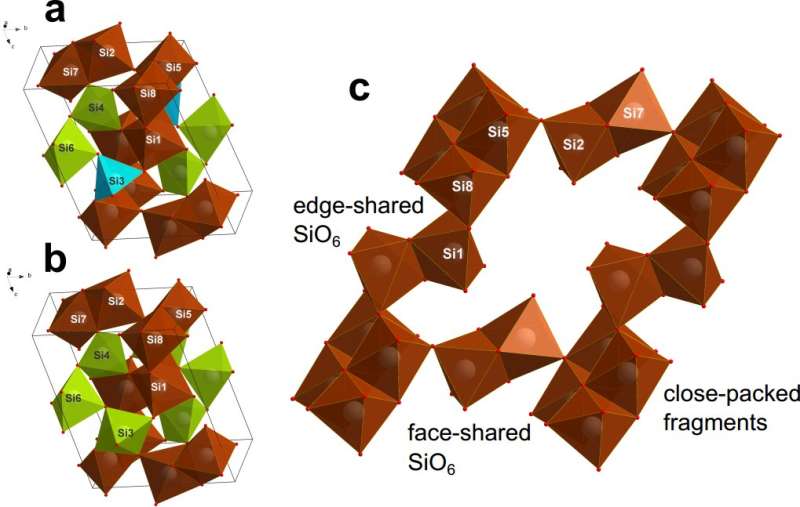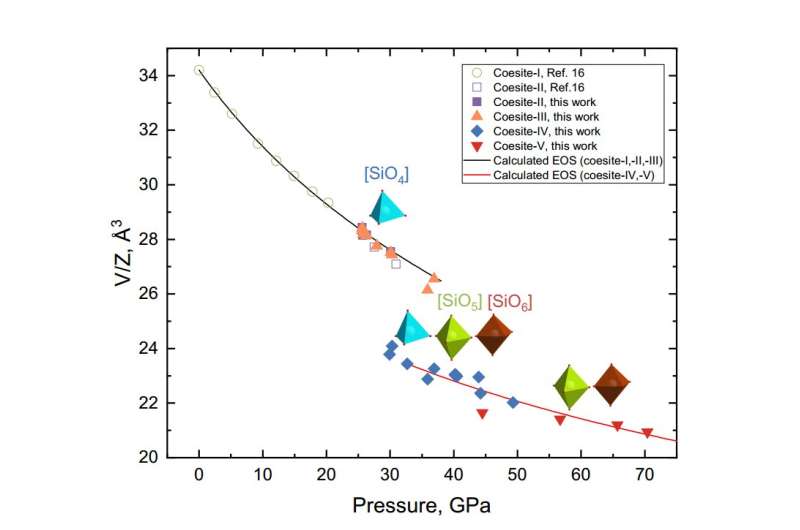These (a), (b) are spatial crystal lattices of coesite, (c) shows 'unwrapped' lattice with clearly visible fragments of SiO6, paradoxically connected by the faces. Credit: NUST MISIS
An international team of physicists and materials scientists from NUST MISIS, Bayerisches Geoinstitut (Germany), Linkoping University (Sweden), and the California Institute of Technology (U.S.) has discovered an "impossible" modification of silica-coesite-IV and coasite-V materials, which seems to defy the generally accepted rules for the formation of chemical bonds in inorganic materials formulated by Linus Pauling, who won the 1954 Nobel Prize in Chemistry for that discovery. The research results were published in Nature Communications on November 15th, 2018.
According to Pauling's rules, the fragments of the atomic lattice in inorganic materials are connected by vertices, because bonding by faces is the most energy-intensive way to form a chemical connection. Therefore, it does not exist in nature. However, scientists have proved, both experimentally and theoretically, using NUST MISIS' supercomputer, that it is possible to form such a connections if the materials are at ultra-high pressure conditions. The obtained results show that fundamentally new classes of materials exist at extreme conditions.
"In our work, we have synthesized and described metastable phases of high-pressure silica: coesite-IV and coesite-V. Their crystal structures are drastically different from any of the earlier described models," says Igor Abrikosov, leader of the theoretical research team. "Two newly discovered coesites contain octahedrons SiO6, that, contrary to Pauling's rule, are connected through common face, which is the most energy-intensive chemical connection. Our results show that the possible silicate magmas in the lower mantle of the Earth can have complex structures, which makes these magmas more compressible than predicted before."
The research team, led by Professor Igor Abrikosov, focused on the study of the materials at ultrahigh pressure. These extreme conditions lead to qualitatively new materials. For instance, in one of the recent papers, scientists reported on the creation of nitrides that were previously thought impossible to obtain.
The dependence of the crystal lattice modification on the pressure/compression. Obviously, under high pressures the structure of the material is complicated - pyramid-pentahedron-hexahedron-octahedron. Credit: NUST MISIS
Information about the structure and mechanical properties of silicon oxide is vital to understanding the processes taking place in Earth's mantle. While studying the structure of the material, which exists at extremely high temperatures and pressures deep in the Earth's interior, the scientists discovered that a special modification of silicon oxide, polymorph coesite, undergoes a number of phase transitions at a pressure of 30 GPa and forms new phases ("coesite-IV" and "coesite-V"), which maintain tetrahedral SiO4 as the main structural elements of the crystal lattice.
In the new experiments, the scientists have gone further by compressing silicon oxide in a diamond anvil to a pressure of more than 30 GPa and observed structural changes in this phase using single-crystal X-ray diffraction. The results are surprising: These structural changes are exceptions to Pauling's rules.
The scientists have discovered two new modifications of coesite (coesite-IV and coesite-V) with structures (Figure 1) that are exceptional and seemingly "impossible" according to classical crystal chemistry: They have pentacoordinated silicon, adjacent octahedrons SiO6, and consist of four-, five- and six-coordinated silicon at the same time. Moreover, several fragments of the atomic lattice connect by faces, not vertices, which should be impossible, according to Pauling's rules.
More information: E. Bykova et al, Metastable silica high pressure polymorphs as structural proxies of deep Earth silicate melts, Nature Communications (2018). DOI: 10.1038/s41467-018-07265-z
Journal information: Nature Communications
Provided by National University of Science and Technology MISIS
























